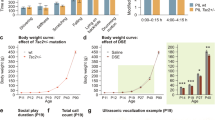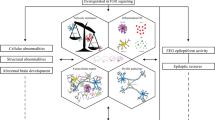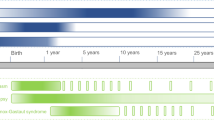Abstract
Epilepsy is a major risk factor for autism spectrum disorder (ASD) and complicates clinical manifestations and management of ASD significantly. Tuberous sclerosis complex (TSC), caused by TSC1 or TSC2 mutations, is one of the medical conditions most commonly associated with ASD and has become an important model to examine molecular pathways associated with ASD. Previous research showed reversal of autism-like social deficits in Tsc1 +/− and Tsc2 +/− mouse models by mammalian target of rapamycin (mTOR) inhibitors. However, at least 70 % of individuals with TSC also have epilepsy, known to complicate the severity and treatment responsiveness of the behavioural phenotype. No previous study has examined the impact of seizures on neurocognitive reversal by mTOR inhibitors. Adult Tsc2 +/− (Eker)-rats express social deficits similar to Tsc2 +/− mice, with additive social deficits from developmental status epilepticus (DSE). DSE was induced by intraperitoneal injection with kainic acid at post-natal days P7 and P14 (n = 12). The experimental group that modelled TSC pathology carried the Tsc2 +/− (Eker)-mutation and was challenged with DSE. The wild-type controls had not received DSE (n = 10). Four-month-old animals were analysed for social behaviour (T1), then treated three times during 1 week with 1 mg/kg everolimus and finally retested in the post-treatment behavioural analysis (T2). In the experimental group, both social interaction and social cognition were impaired at T1. After treatment at T2, behaviour in the experimental group was indistinguishable from controls. The mTOR inhibitor, everolimus, reversed social deficit behaviours in the Tsc2 haploinsufficiency plus DSE animal model to control levels.




Similar content being viewed by others
References
Baird G, Simonoff E, Pickles A et al (2006) Prevalence of disorders of the autism spectrum in a population cohort of children in South Thames: the Special Needs and Autism Project (SNAP). Lancet 368:210–215
Tuchman R, Rapin I (2002) Epilepsy in autism. Lancet Neurol 1:352–358
Curatolo P, Moavero R, de Vries PJ (2015) Neurological and neuropsychiatric aspects of tuberous sclerosis complex. Lancet Neurol 14:733–745. doi:10.1016/S1474-4422(15)00069-1
Ehninger D, Han S, Shilyansky C et al (2008) Reversal of learning deficits in a Tsc2+/− mouse model of tuberous sclerosis. Nat Med 14:843–848
Tsai PT, Hull C, Chu Y et al (2013) Autistic-like behavior and cerebellar dysfunction in Purkinje cell Tsc1 mutant mice. Nature 488:647–651
Sato A, Kasai S, Kobayashi T et al (2012) Rapamycin reverses impaired social interaction in mouse models of tuberous sclerosis complex. Nat Commun 3:1292. doi:10.1038/ncomms2295
Riikonen R, Amnell G (1981) Psychiatric disorders in children with earlier infantile spasms. Dev Med Child Neurol 23:747–760
Primec ZR, Stare J, Neubauer D (2006) The risk of lower mental outcome in infantile spasms increases after three weeks of hypsarrhythmia duration. Epilepsia 47:2202–2205
Goh S, Kwiatkowski DJ, Dorer DJ, Thiele EA (2005) Infantile spasms and intellectual outcomes in children with tuberous sclerosis complex. Neurology 65:235–238
O’Callaghan FJ, Harris T, Joinson C et al (2004) The relation of infantile spasms, tubers, and intelligence in tuberous sclerosis complex. Arch Dis Child 89:530–533
Workman AD, Charvet CJ, Clancy B et al (2013) Modeling transformations of neurodevelopmental sequences across mammalian species. J Neurosci 33:7368–7383. doi:10.1523/JNEUROSCI.5746-12.2013
Lynch M, Sayin U, Bownds J et al (2000) Long-term consequences of early postnatal seizures on hippocampal learning and plasticity. Eur J Neurosci 12:2252–2264
Sayin U, Sutula TP, Stafstrom CE (2004) Seizures in the developing brain cause adverse long-term effects on spatial learning and anxiety. Epilepsia 45:1539–1548
Ikonomidou C, Bosch F, Miksa M et al (1999) Blockade of NMDA receptors and apoptotic neurodegeneration in the developing brain. Science 283:70–74
Lim AL, Taylor DA, Malone DT (2012) Consequences of early life MK-801 administration: long-term behavioural effects and relevance to schizophrenia research. Behav Brain Res 227:276–286. doi:10.1016/j.bbr.2011.10.052
von der Brelie C, Waltereit R, Zhang L et al (2006) Impaired synaptic plasticity in a rat model of tuberous sclerosis. Eur J Neurosci 23:686–692. doi:10.1111/j.1460-9568.2006.04594.x
Waltereit R, Welzl H, Dichgans J et al (2006) Enhanced episodic-like memory and kindling epilepsy in a rat model of tuberous sclerosis. J Neurochem 96:407–413
Waltereit R, Japs B, Schneider M et al (2011) Epilepsy and Tsc2 haploinsufficiency lead to autistic-like social deficit behaviors in rats. Behav Genet 41:364–372
Kenerson HL, Aicher LD, True LD, Yeung RS (2002) Activated mammalian target of rapamycin pathway in the pathogenesis of tuberous sclerosis complex renal tumors. Cancer Res 62:5645–5650
Kenerson H, Dundon TA, Yeung RS (2005) Effects of rapamycin in the Eker rat model of tuberous sclerosis complex. Pediatr Res 57:67–75. doi:10.1203/01.PDR.0000147727.78571.07
O’Reilly T, McSheehy PMJ, Kawai R et al (2009) Comparative pharmacokinetics of RAD001 (everolimus) in normal and tumor-bearing rodents. Cancer Chemother Pharmacol 65:625–639
Rennebeck G, Kleymenova EV, Anderson R et al (1998) Loss of function of the tuberous sclerosis 2 tumor suppressor gene results in embryonic lethality characterized by disrupted neuroepithelial growth and development. Proc Natl Acad Sci USA 95:15629–15634
Schneider M, Schomig E, Leweke FM (2008) Acute and chronic cannabinoid treatment differentially affects recognition memory and social behavior in pubertal and adult rats. Addict Biol 13:345–357
Meikle L, Pollizzi K, Egnor A et al (2008) Response of a neuronal model of tuberous sclerosis to mammalian target of rapamycin (mTOR) inhibitors: effects on mTORC1 and Akt signaling lead to improved survival and function. J Neurosci 28:5422–5432. doi:10.1523/JNEUROSCI.0955-08.2008
Rutter M, Bishop D, Pine D et al (2010) Rutter’s child and adolescent psychiatry, 5th edn. Wiley-Blackwell, Hoboken
Ishii R, Wataya-Kaneda M, Canuet L et al (2015) Everolimus improves behavioral deficits in a patient with autism associated with tuberous sclerosis: a case report. Neuropsychiatr Electrophysiol 1:6. doi:10.1186/s40810-015-0004-x
Chu-Shore CJ, Major P, Camposano S et al (2010) The natural history of epilepsy in tuberous sclerosis complex. Epilepsia 51:1236–1241. doi:10.1111/j.1528-1167.2009.02474.x
Deykin EY, MacMahon B (1979) The incidence of seizures among children with autistic symptoms. Am J Psychiatry 136:1310–1312
Woolfenden S, Sarkozy V, Ridley G et al (2012) A systematic review of two outcomes in autism spectrum disorder—epilepsy and mortality. Dev Med Child Neurol 54:306–312. doi:10.1111/j.1469-8749.2012.04223.x
Tuchman R, Cuccaro M (2011) Epilepsy and autism: neurodevelopmental perspective. Curr Neurol Neurosci Rep 11:428–434. doi:10.1007/s11910-011-0195-x
Smalley SL (1998) Autism and tuberous sclerosis. J Autism Dev Disord 28:407–414
Gomez MR, Sampson JR, Whittemore VH (1999) The tuberous sclerosis complex. Oxford University Press, New York
de Vries PJ, Prather PA (2007) The tuberous sclerosis complex. N Engl J Med 356:92
Zeng L-H, Xu L, Gutmann DH, Wong M (2008) Rapamycin prevents epilepsy in a mouse model of tuberous sclerosis complex. Ann Neurol 63:444–453. doi:10.1002/ana.21331
Krueger DA, Wilfong AA, Holland-Bouley K et al (2013) Everolimus treatment of refractory epilepsy in tuberous sclerosis complex. Ann Neurol 74:679–687. doi:10.1002/ana.23960
Wong M (2013) A critical review of mTOR inhibitors and epilepsy: from basic science to clinical trials. Expert Rev Neurother 13:657–669. doi:10.1586/ern.13.48
de Vries PJ, Howe CJ (2007) The tuberous sclerosis complex proteins—a GRIPP on cognition and neurodevelopment. Trends Mol Med 13:319–326
Ehninger D, de Vries PJ, Silva AJ (2009) From mTOR to cognition: molecular and cellular mechanisms of cognitive impairments in tuberous sclerosis. J Intellect Disabil Res 53:838–851
Napolioni V, Moavero R, Curatolo P (2009) Recent advances in neurobiology of Tuberous Sclerosis Complex. Brain Dev 31:104–113. doi:10.1016/j.braindev.2008.09.013
Acknowledgments
The work was supported by an investigator-initiated research grant from Novartis Germany to R.W. Everolimus formulation was supplied by Novartis, Basel, Switzerland. P.J.dV. was supported by the National Research Foundation of South Africa, the Programme for the Enhancement of Research Capacity (University of Cape Town) and the Struengmann Fund. Author’s contributions: R.W. designed research, M.S, K.S. and R.W. performed research, M.S. contributed new analytical tools, M.S. and R.W. analysed data, and M.S., P.J.dV., K.S., V.R. and R.W. wrote the paper. We thank Dr. David Kwiatkowski and Dr. Karsten Palfner for valuable discussions. We are grateful to Christian Gluch and Lena Wendler for excellent technical assistance.
Author information
Authors and Affiliations
Corresponding author
Ethics declarations
Conflict of interest
The authors declare that they have no conflict of interest.
Rights and permissions
About this article
Cite this article
Schneider, M., de Vries, P.J., Schönig, K. et al. mTOR inhibitor reverses autistic-like social deficit behaviours in adult rats with both Tsc2 haploinsufficiency and developmental status epilepticus. Eur Arch Psychiatry Clin Neurosci 267, 455–463 (2017). https://doi.org/10.1007/s00406-016-0703-8
Received:
Accepted:
Published:
Issue Date:
DOI: https://doi.org/10.1007/s00406-016-0703-8




